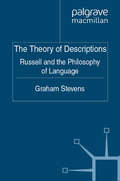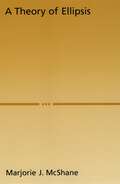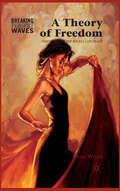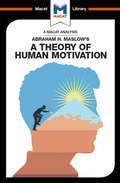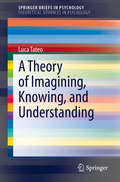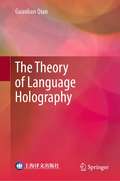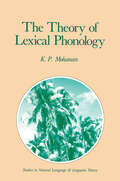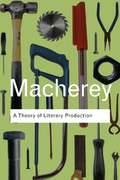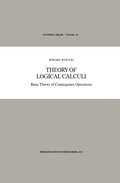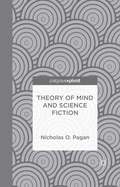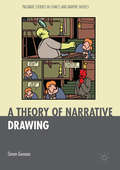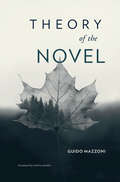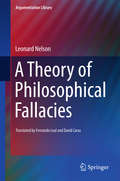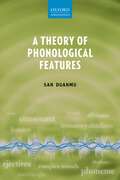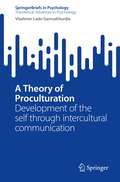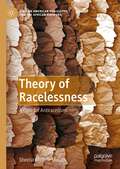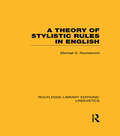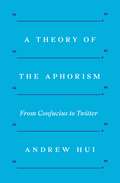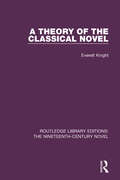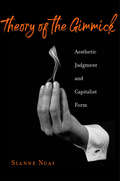- Table View
- List View
The Theory of Descriptions: Russell and the Philosophy of Language (History of Analytic Philosophy)
by G. StevensThe book combines a historical and philosophical study of Russell's theory of descriptions. It defends, develops and extends the theory as a contribution to natural language semantics while also arguing for a reassessment of the important of linguistic inquiry to Russell's philosophical project.
A Theory of Ellipsis
by Marjorie J. McShaneEllipsis is the non-expression of one or more sentence elements whose meaning can be reconstructed either from the context or from a person's knowledge of the world. In speech and writing, ellipsis is pervasive, contributing in various ways to the economy, speed, and style of communication. Resolving ellipsis is a particularly challenging issue in natural language processing, since not only must meaning be gleaned from missing elements but the fact that something meaningful is missing must be detected in the first place. Marjorie McShane presents a comprehensive theory of ellipsis that supports the formal, cross-linguistic description of elliptical phenomena taking into account the various factors that affect the use of ellipsis. A methodology is suggested for creating a parameter space describing and treating ellipsis in any language. Such "ellipsis profiles" of languages will serve a wide range of practical applications, including but not limited to natural language processing. In contrast to earlier work, this theory focuses not only on what can, in principle, be elided but in what circumstances a given category actually would or would not be elided--that is, what renders ellipsis mandatory or infelicitous. A theory of ellipsis has been elusive because to produce an adequate account of this ubiquitous phenomenon one needs to address and integrate data from a wide variety of linguistic research areas. Using data primarily from Russian, English, and Polish, McShane looks at the big picture of ellipsis, integrating the syntactic, semantic, morphological, and pragmatic heuristics and bridges work on ellipsis with the larger study of reference. This is groundbreaking linguistic scholarship that bridges the theoretical and the applied, and will interest scholars in the fields of computational, descriptive, and theoretical linguistics.
A Theory of Freedom: Feminism and the Social Contract (Breaking Feminist Waves)
by S. WelchThis book offers a liberatory conception of individual freedom that uniquely responds to the problems of social oppression and demands of the interrelatedness insofar as it pertains specifically to the social domain of activity.
A Theory of Human Motivation (The Macat Library)
by Stoyan StoyanovUS psychologist Abraham H. Maslow’s A Theory of Human Motivation is a classic of psychological research that helped change the field for good. Like many field-changing thinkers, Maslow was not just a talented researcher, he was also a creative thinker – able to see things from a new perspective and show them in a different light. At a time when psychology was dominated by two major schools of thought, Maslow was able to forge a new, third paradigm, that remains influential today. Sigmund Freud’s psychoanalysis had developed the idea of understanding the mind through dialogue between patient and analyst. The behaviorism of Ivan Pavlov and John Watson had focused on comprehending the mind through behaviors that could be measured, trained, and changed. Maslow, however, generated new ideas, forging what he called “positive” or “humanistic psychology”. His argument was that humans are psychologically motivated by a series of hierarchical needs, starting with the most essential first. Maslow thought it important for the advancement of psychology to identify, group and rank these needs in terms of priority. His belief in the value of this third way was important in leading those who studied psychology to redefine the discipline, and so see it in new ways.
A Theory of Imagining, Knowing, and Understanding (SpringerBriefs in Psychology)
by Luca TateoThis is a book about imaginative work and its relationship with the construction of knowledge. It is fully acknowledged by epistemologists that imagination is not something opposed to rationality; it is not mere fantasy opposed to intellect. In philosophy and cognitive sciences, imagination is generally “delimiting not much more than the mental ability to interact cognitively with things that are not now present via the senses.” (Stuart, 2017, p. 11) For centuries, scholars and poets have wondered where this capability could come from, whether it is inspired by divinity or it is a peculiar feature of human mind (Tateo, 2017b). The omnipresence of imaginative work in both every day and highly specialized human activities requires a profoundly radical understanding of this phenomenon. We need to work imaginatively in order to achieve knowledge, thus imagination must be something more than a mere flight of fantasy. Considering different stories in the field of scientific endeavor, I will try to propose the idea that the imaginative process is fundamental higher mental function that concurs in our experiencing, knowing and understanding the world we are part of. This book is thus about a theoretical idea of imagining as constant part of the complex whole we call the human psyche. It is a story of human beings striving not only for knowledge and exploration but also striving for imagining possibilities.
The Theory of Language Holography
by Guanlian QianThis book presents a method of linking the ordered structure of the cosmos with human thoughts: the theory of language holography. In the view presented here, the cosmos is in harmony with the human body and language, and human thoughts are holographic with the cosmos at the level of language. In a word, the holographic relation is nothing more than the bridge by means of which Guanlian Qian connects the cosmos, human, and language. This is a vitally important contribution to linguistic and philosophical studies that cannot be ignored.The book has two main focus areas: outer language holography and inner language holography. These two areas constitute the core of the dynamic and holistic view put forward in the theory of language holography. The book’s main properties can be summarized into the following points: First and foremost, it is a book created in toto by a Chinese scholar devoted to pragmatics, theoretical linguistics, and philosophy of language. Secondly, the book was accepted by a top Chinese publisher and was republished the second year, which reflected its value and appeal. Thirdly, in terms of writing style, the book is characterized by succinctness and logic. As a result, it reads fluidly and smoothly without redundancies, which is not that common in linguistic or even philosophical works. Lastly, as stated by the author in the introduction, “Creation is the development of previous capacities, but it is also the generation of new ones”; this book can be said to put this concept into practice. Overall, the book offers a unique resource to readers around the world who want to know more about the truly original and innovative studies of language in Chinese academia.
The Theory of Lexical Phonology (Studies in Natural Language and Linguistic Theory #6)
by K.P. MohananA Theory of Literary Production
by Pierre MachereyWho is more important: the reader, or the writer? Originally published in French in 1966, Pierre Macherey’s first and most famous work, A Theory of Literary Production dared to challenge perceived wisdom, and quickly established him as a pivotal figure in literary theory. The reissue of this work as a Routledge Classic brings some radical ideas to a new audience, and argues persuasively for a totally new way of reading. As such, it is an essential work for anyone interested in the development of literary theory.
A Theory of Literary Production
by Pierre MachereyWho is more important: the reader, or the writer? Originally published in French in 1966, Pierre Macherey’s first and most famous work, A Theory of Literary Production dared to challenge perceived wisdom, and quickly established him as a pivotal figure in literary theory. The reissue of this work as a Routledge Classic brings some radical ideas to a new audience, and argues persuasively for a totally new way of reading. As such, it is an essential work for anyone interested in the development of literary theory.
Theory of Logical Calculi: Basic Theory of Consequence Operations (Synthese Library #199)
by Ryszard WójcickiTheory of Mind and Science Fiction
by N. PaganTheory of Mind and Science Fiction shows how theory of mind provides an exciting 'new' way to think about science fiction and, conversely, how science fiction sheds light not only on theory of mind but also empathy, morality, and the nature of our humanity.
A Theory of Narrative Drawing (Palgrave Studies in Comics and Graphic Novels)
by Simon GrennanThis book offers an original new conception of visual story telling, proposing that drawing, depictive drawing and narrative drawing are produced in an encompassing dialogic system of embodied social behavior. It refigures the existing descriptions of visual story-telling that pause with theorizations of perception and the articulation of form. The book identifies and examines key issues in the field, including: the relationships between vision, visualization and imagination; the theoretical remediation of linguistic and narratological concepts; the systematization of discourse; the production of the subject; idea and institution; and the significance of resources of the body in depiction, representation and narrative. It then tests this new conception in practice: two original visual demonstrations clarify the particular dialectic relationships between subjects and media, in an examination of drawing style and genre, social consensus and self-conscious constraint. The book’s originality derives from its clear articulation of a wide range of sources in proposing a conception of narrative drawing, and the extrapolation of this new conception in two new visual demonstrations.
Theory Of The Novel (pdf)
by Guido Mazzoni Zakiya HanafiIn his theory of the novel, Guido Mazzoni explains that novels consist of stories told in any way whatsoever about the experiences of ordinary men and women who exist as contingent beings within time and space. Novels allow readers to step into other lives and other versions of truth, each a small, local world, absolute in its particularity.
A Theory of Philosophical Fallacies (Argumentation Library #26)
by Leonard NelsonPresented as a Vorlesung in the German philosophical tradition, this book presents the most detailed account of Nelson’s method of argument analysis, celebrated by many luminaries such as Karl Popper. It was written in 1921 in opposition to the relativistic, subjectivistic and nihilistic tendencies of Nelson’s time. The book contains an exposition of a method that is a further development of Kant’s transcendental dialectics, followed by an application to the critical analysis of arguments by many famous thinkers, including Bentham, Mill, Poincaré, Leibniz, Hegel, Einstein, Bergson, Rickert, Simmel, Brentano, Stammler, Jellinek, Dingler, and Meinong. The book presents a general theory of philosophical argumentation as seen from the viewpoint of the typical fallacies committed by anybody arguing philosophically, whether professional philosophers or philosophical laypeople. Although the nature of philosophy and philosophical argumentation is one of the most recurrent objects of reflection for philosophers, this book represents the first attempt at a general theory of philosophical fallacy. According to Nelson, it is in the shape of false dilemmas that errors in reasoning always emerge, and false dilemmas are always the result of the same mechanism--the unwitting replacement of one concept for another.
A Theory of Phonological Features
by San DuanmuThis book outlines a system of phonological features that is minimally sufficient to distinguish all consonants and vowels in the languages of the world. The extensive evidence is drawn from datasets with a combined total of about 1000 sound inventories. The interpretation of phonetic transcriptions from different languages is a long-standing problem. In this book, San Duanmu proposes a solution that relies on the notion of contrast: X and Y are different sounds if and only if they contrast in some language. He focuses on a simple procedure to interpret empirical data: for each phonetic dimension, all inventories are searched in order to determine the maximal number of contrasts required. In addition, every unusual feature or extra degree of contrast is re-examined to confirm its validity. The resulting feature system is surprisingly simple: fewer features are needed than previously proposed, and for each feature, a two-way contrast is sufficient. Nevertheless, the proposal is reliable in that the notion of contrast is uncontroversial, the procedure is explicit, and the result is repeatable. The book also offers discussion of non-contrastive differences between languages, sound classes, and complex sounds such as affricates, consonant-glide units, consonant-liquid units, contour tones, pre-nasalized stops, clicks, ejectives, and implosives.
A Theory of Proculturation: Development of the self through intercultural communication (SpringerBriefs in Psychology)
by Vladimer Lado GamsakhurdiaIn each connection with new cultural contexts a new hybrid state of cultural adaptation is constructed enabling people to adjust to new conditions by creating innovative solutions for the self. This book aims to provide a brief presentation of innovative cultural psychological theory of proculturation reflecting and oriented on the understanding of semiotic and developmental dynamics of higher mental phenomena while engaging alien signs through intercultural communication. The exploration and theoretical understanding of developmental dynamics (such as self and identity construction) of people who live in immigration or multicultural, or even multi-ethnic societies, the research builds its new focus in contrasts with the acculturation theories currently present in social psychology. The theory of proculturation has been built in opposition to cross-cultural psychological theories as well as mainstream theories of acculturation research dominated by bidimensional theoretical models. Instead, this theory is constructed based on theoretical explorations which are rooted in cultural semiotics and developmental psychological paradigm on human psychology.
Theory of Racelessness: A Case for Antirace(ism) (African American Philosophy and the African Diaspora)
by Sheena Michele MasonThis book presents a skeptical eliminativist philosophy of race and the theory of racelessness, a methodological and pedagogical framework for analyzing "race" and racism. It explores the history of skeptical eliminativism and constructionist eliminativism within the history of African American philosophy and literary studies and its consistent connection with movements for civil rights. Sheena M. Mason considers how current anti-racist efforts reflect naturalist conservationist and constructionist reconstructionist philosophies of race that prevent more people from fully confronting the problem of racism, not race, thereby enabling racism to persist. She then offers a three-part solution for how scholars and people aspiring toward anti-racism can avoid unintentionally upholding racism, using literary studies as a case study to show how "race" often translates into racism itself. The theory of racelessness helps more people undo racism by undoing the belief in "race."
A Theory of Stylistic Rules in English (Routledge Library Editions: Linguistics)
by Michael RochemontThis book defends in part a particular elaboration of the stylistic rule component of the grammatical model first presented in Chomsky and Lasnik (1977). It is argued that stylistic rules share a number of fundamental properties, most significantly that they characterize noncanonical focusing constructions and that they make no contribution to the logical forms (LFs) of sentences they apply to in particular regard to truth conditional interpretation. The work includes a discussion of Auxiliary Inversion constructions in English, arguing that these constructions also sometimes involve focusing, though not stylistic. An approach to the interpretation of these sentences is suggested, employing a concept of interpretative templates: rules relating S-structure and LF for which some independent evidence is suggested.
A Theory of Stylistic Rules in English (Routledge Library Editions: Linguistics)
by Michael RochemontThis book defends in part a particular elaboration of the stylistic rule component of the grammatical model first presented in Chomsky and Lasnik (1977). It is argued that stylistic rules share a number of fundamental properties, most significantly that they characterize noncanonical focusing constructions and that they make no contribution to the logical forms (LFs) of sentences they apply to in particular regard to truth conditional interpretation. The work includes a discussion of Auxiliary Inversion constructions in English, arguing that these constructions also sometimes involve focusing, though not stylistic. An approach to the interpretation of these sentences is suggested, employing a concept of interpretative templates: rules relating S-structure and LF for which some independent evidence is suggested.
A Theory of the Aphorism: From Confucius to Twitter
by Andrew HuiAn engaging look at the aphorism, the shortest literary form, across time, languages, and culturesAphorisms—or philosophical short sayings—appear everywhere, from Confucius to Twitter, the Buddha to the Bible, Heraclitus to Nietzsche. Yet despite this ubiquity, the aphorism is the least studied literary form. What are its origins? How did it develop? How do religious or philosophical movements arise from the enigmatic sayings of charismatic leaders? And why do some of our most celebrated modern philosophers use aphoristic fragments to convey their deepest ideas? In A Theory of the Aphorism, Andrew Hui crisscrosses histories and cultures to answer these questions and more.With clarity and precision, Hui demonstrates how aphorisms—ranging from China, Greece, and biblical antiquity to the European Renaissance and nineteenth century—encompass sweeping and urgent programs of thought. Constructed as literary fragments, aphorisms open new lines of inquiry and horizons of interpretation. In this way, aphorisms have functioned as ancestors, allies, or antagonists to grand systems of philosophy.Encompassing literature, philology, and philosophy, the history of the book and the history of reading, A Theory of the Aphorism invites us to reflect anew on what it means to think deeply about this pithiest of literary forms.
A Theory of the Aphorism: From Confucius to Twitter
by Andrew HuiAn engaging look at the aphorism, the shortest literary form, across time, languages, and culturesAphorisms—or philosophical short sayings—appear everywhere, from Confucius to Twitter, the Buddha to the Bible, Heraclitus to Nietzsche. Yet despite this ubiquity, the aphorism is the least studied literary form. What are its origins? How did it develop? How do religious or philosophical movements arise from the enigmatic sayings of charismatic leaders? And why do some of our most celebrated modern philosophers use aphoristic fragments to convey their deepest ideas? In A Theory of the Aphorism, Andrew Hui crisscrosses histories and cultures to answer these questions and more.With clarity and precision, Hui demonstrates how aphorisms—ranging from China, Greece, and biblical antiquity to the European Renaissance and nineteenth century—encompass sweeping and urgent programs of thought. Constructed as literary fragments, aphorisms open new lines of inquiry and horizons of interpretation. In this way, aphorisms have functioned as ancestors, allies, or antagonists to grand systems of philosophy.Encompassing literature, philology, and philosophy, the history of the book and the history of reading, A Theory of the Aphorism invites us to reflect anew on what it means to think deeply about this pithiest of literary forms.
A Theory of the Classical Novel (Routledge Library Editions: The Nineteenth-Century Novel)
by Everett KnightFirst published in 1969, this book asserts that two concepts, structure and praxis, make it impractical for scholars to ignore the necessity of a theory of the novel — with the term ‘classical novel’ used to cover western fiction. The author argues that the novel is fundamentally an ‘enterprise’ — an aspect of the praxis of a particular social class — and that the ways of orthodox scholarship are also a praxis. The investigator must enquire into the nature of their questions as those traditionally put to literature are inspired by ‘irrelevant’ nineteenth century positivism. In the author’s view the book is necessarily a theory of the classical novel and a manifesto for the student movement.
A Theory of the Classical Novel (Routledge Library Editions: The Nineteenth-Century Novel)
by Everett KnightFirst published in 1969, this book asserts that two concepts, structure and praxis, make it impractical for scholars to ignore the necessity of a theory of the novel — with the term ‘classical novel’ used to cover western fiction. The author argues that the novel is fundamentally an ‘enterprise’ — an aspect of the praxis of a particular social class — and that the ways of orthodox scholarship are also a praxis. The investigator must enquire into the nature of their questions as those traditionally put to literature are inspired by ‘irrelevant’ nineteenth century positivism. In the author’s view the book is necessarily a theory of the classical novel and a manifesto for the student movement.
Theory of the Gimmick: Aesthetic Judgment and Capitalist Form
by Sianne NgaiA provocative theory of the gimmick as an aesthetic category steeped in the anxieties of capitalism. Repulsive and yet strangely attractive, the gimmick is a form that can be found virtually everywhere in capitalism. It comes in many guises: a musical hook, a financial strategy, a striptease, a novel of ideas. Above all, acclaimed theorist Sianne Ngai argues, the gimmick strikes us both as working too little (a labor-saving trick) and as working too hard (a strained effort to get our attention). Focusing on this connection to work, Ngai draws a line from gimmicks to political economy. When we call something a gimmick, we are registering uncertainties about value bound to labor and time—misgivings that indicate broader anxieties about the measurement of wealth in capitalism. With wit and critical precision, Ngai explores the extravagantly impoverished gimmick across a range of examples: the fiction of Thomas Mann, Helen DeWitt, and Henry James; photographs by Torbjørn Rødland; the video art of Stan Douglas; the theoretical writings of Stanley Cavell and Theodor Adorno. Despite its status as cheap and compromised, the gimmick emerges as a surprisingly powerful tool in this formidable contribution to aesthetic theory.
Theory of the Lyric
by Jonathan CullerWhat sort of thing is a lyric poem? An intense expression of subjective experience? The fictive speech of a specifiable persona? Examining ancient and modern poems from Sappho to Ashbery, Jonathan Culler reveals the limitations of these two models—the Romantic and the modern—and challenges the assumption that poems exist to be interpreted.
